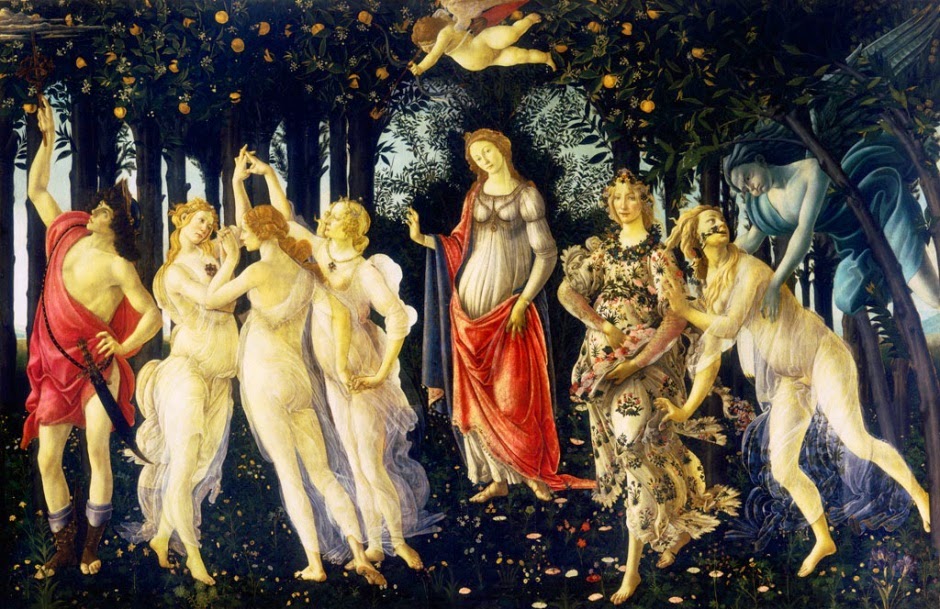Botticelli: La Primavera
DEFINITELY CLICK TO VIEW LARGE IMAGE
We watched Rick Steves reporting from Florence the other night, which means lots and lots of paintings of the Madonna and Child, and of course, the great Davids of Donatello and Michelangelo. But the Renaissance wasn't just about the humanizing of Christian archetypes; it was greatly concerned with reviving and celebrating the ideas and aesthetics of the ancient Greeks and Romans. So just when you think you can't ponder the baby Jesus even one more time, you can encounter a masterpiece of paganism such as Botticelli's "La Primavera," which means spring in Italian.
There's a lot of symbolism going on, but let's just note that that's Venus, the Goddess of Love and Beauty, in the middle, with that chubby rascal Cupid floating above her. Cupid, as we know, represents eros, or the forms of love based on desire. Cupid's arrow penetrates, which doesn't merely mean sexually, but also spiritually, in that our hearts are pierced, entered into, by our beloved. Our hearts can also be pierced by beauty -- and not just the beauty of our beloved, but the beauty of art, justice, nature, and existence itself.
Curiously, Venus looks somewhat neutral, which seems significant given all the desire and fertility and sensuality happening around her. Perhaps that sense of remove in some way represents agape, another distinct form of love identified by the Greeks. Agape love is disinterested: it's not addressed to or concerned with any one person in particular. That's why agape is associated with compassion, and why it is often symbolized by rainfall, which makes possible all the nourishment and replenishment of the world.
 |
| Botticelli, Primavera, 1482, approx. 7' x 10' |
We watched Rick Steves reporting from Florence the other night, which means lots and lots of paintings of the Madonna and Child, and of course, the great Davids of Donatello and Michelangelo. But the Renaissance wasn't just about the humanizing of Christian archetypes; it was greatly concerned with reviving and celebrating the ideas and aesthetics of the ancient Greeks and Romans. So just when you think you can't ponder the baby Jesus even one more time, you can encounter a masterpiece of paganism such as Botticelli's "La Primavera," which means spring in Italian.
There's a lot of symbolism going on, but let's just note that that's Venus, the Goddess of Love and Beauty, in the middle, with that chubby rascal Cupid floating above her. Cupid, as we know, represents eros, or the forms of love based on desire. Cupid's arrow penetrates, which doesn't merely mean sexually, but also spiritually, in that our hearts are pierced, entered into, by our beloved. Our hearts can also be pierced by beauty -- and not just the beauty of our beloved, but the beauty of art, justice, nature, and existence itself.
Curiously, Venus looks somewhat neutral, which seems significant given all the desire and fertility and sensuality happening around her. Perhaps that sense of remove in some way represents agape, another distinct form of love identified by the Greeks. Agape love is disinterested: it's not addressed to or concerned with any one person in particular. That's why agape is associated with compassion, and why it is often symbolized by rainfall, which makes possible all the nourishment and replenishment of the world.
Fascinating—I like the cut of the guy on the left, and the flowered dress on the right.
ReplyDelete(I know! What a philistine!)
You don't know much about art, but you know what you like, as they say, Deborah.
ReplyDelete